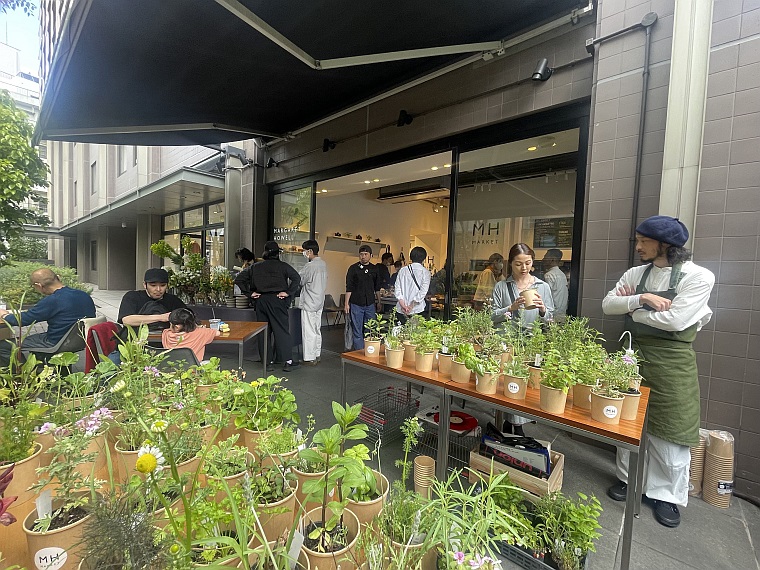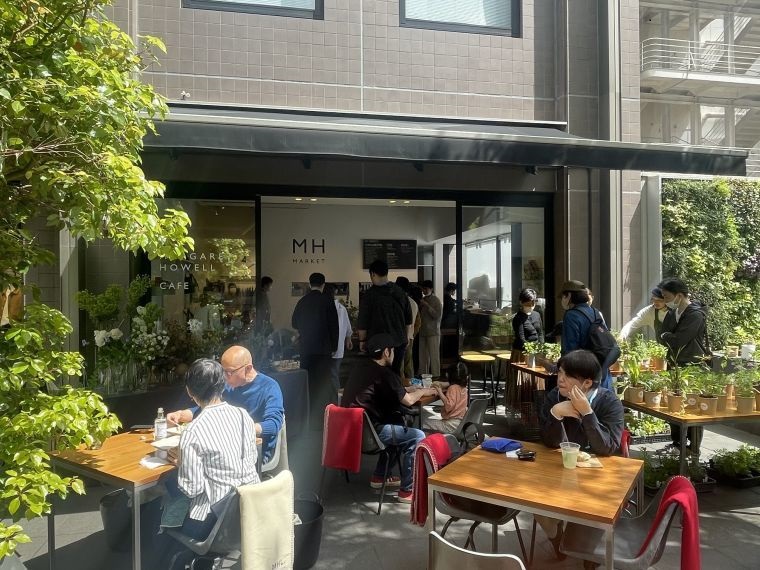You are using an out of date browser. It may not display this or other websites correctly.
You should upgrade or use an alternative browser.
You should upgrade or use an alternative browser.
Margaret Howell - Designer
- Thread starter Johnny
- Start date
Lena - no problem -I enjoy hearing all the views!! Its also very interesting to see how tastes differ between the US & UK folks... are there many french/japanese members here? :Originally posted by helena+Apr 30th, 2004 - 10:25 am--><div class='quotetop'>QUOTE(helena @ Apr 30th, 2004 - 10:25 am)</div><div class='quotemain'> <!--QuoteBegin-Lena@Apr 30th, 2004 - 3:20 am
thanks for bringing this in Johnny & Helena (for the link)
 [/b][/quote]
[/b][/quote]Fujiyn, she is French and a lovely person. Great to talk to.
MissMagAddict
Well-Known Member
- Joined
- Feb 2, 2005
- Messages
- 26,630
- Reaction score
- 1,309
Unknownpleasures
Active Member
- Joined
- Jun 9, 2010
- Messages
- 2,242
- Reaction score
- 3
Wow.she's really pretty! and she lives in such a classy, nice place.
I've always liked her collections (what I've seen) I love the cuts and the masculinity and at the same time feminity (in a good way) of the clothes she makes.
I've always liked her collections (what I've seen) I love the cuts and the masculinity and at the same time feminity (in a good way) of the clothes she makes.
MissMagAddict
Well-Known Member
- Joined
- Feb 2, 2005
- Messages
- 26,630
- Reaction score
- 1,309
View attachment 658757
FORM AND FUNCTION | Margaret Howell in her design studio
FORM AND FUNCTION | Margaret Howell in her design studio
source | wsj.comMargaret Howell | With a utilitarian approach to luxury, an affinity for masculine tailoring and collaborations outside the fashion world, the British designer has won legions of followers at home and abroad.
By Gaby Wood
WHEN I ASK MARGARET HOWELL if she designs with a certain woman in mind, she shrugs and replies, "The modern woman, who doesn't want to be restricted." Asked for specifics, she names Jane Birkin, Katharine Hepburn and Inès de la Fressange among her inspirations. The range—across decades, looks and character types—makes me laugh, because of course that doesn't narrow it down at all, and this is Howell's gift: to see style where it already exists, and to describe a person and a purpose before she mentions the clothes.
It means that although Howell has a rigorous aesthetic—which has grown, since the 1970s, out of the simple luxury and ease of dressing both men and women in men's clothing—anyone can wear it, and does. Today, her fans include Alexa Chung, Bill Nighy, Frances McDormand and a dedicated following in Japan.
Howell is widely admired for what the fashion historian Colin McDowell describes as her "intellectual and creative integrity." Kenneth Grange—the illustrious British designer of everything from Parker pens to high-speed trains, who recently collaborated with Howell on a slate-gray shirt—says: "What makes her so unique is that she manages to flourish in a lunatic world of silly clothes for often silly people."
At her headquarters in Wigmore Street, in central London, she works behind the scenes of a deep, naturally lit shop that sells not only her clothes but also furniture and books. Ercol chairs, Anglepoise lamps and other classics of postwar British design are carefully positioned next to handmade porcelain and a selection of monographs on like-minded artists: the sculptor Barbara Hepworth or the late "cutlery king" David Mellor. Howell herself is precise and petite. There is a quiet thoughtfulness about her, and a suggestion in her demeanor that things could always be more simple. "I think clothing should have a reason for being designed, and a sort of character to it," Howell tells me. That, she adds, can be the hardest thing to achieve: "Sometimes it can just be clothing."
"Utilitarian" is by now just another look in the lexicon of fashion, but for the 66-year-old Howell, utility is both fact and inspiration. The clothes must be made expertly from the correct cloth—she has been working with the same suppliers of traditional men's shirting, for example, for 40 years. And they are often reminiscent of a specific period or practice: Soft-hanging jackets that hark back to working-men's clubs in '50s London. Her more recent second line, MHL, began with a simple cotton jersey top based on a found ex-army sports shirt. The look is so unostentatious as to be nearly invisible to the untrained eye, yet it all stems, as Howell remarks, "from a very personal point of view."
Howell's fashion career began in the late '60s. After studying fine art at Goldsmiths College in London, she hand-made necklaces and sold them. Then she made a shirt. At that time, men's shirts were either very formal or exaggeratedly "designer." Howell used traditional fabrics to produce a relaxed and quiet style. Working at first from home, she was compelled to expand operations when Joseph Ettedgui asked to stock her shirts in his then-new eponymous shop—a key endorsement that helped launch her as a designer. Howell went on to make an unlined linen jacket, and then trousers using a robust corduroy. In every case she was inspired by locally produced fabric. And women wanted to wear it too. This was the Annie Hall era, but Howell's way of wedding Katharine Hepburn to Walter Gropius—a '30s sense of modernity—has never had a problem finding fans.
This kind of authenticity has become its own form of luxury: Where else will you find wide-legged trousers made of hand-dyed tweed, or old-school shirting combined with thick cashmere and a flirty take on tartan? McDowell loves "the way she eschews dressing a catwalk fantasy figure in favor of suggesting clothes for real people who want quality—not what mainstream fashion thinks are classics but are real classics to be treasured and worn for many seasons to come." Howell herself believes this is the key to her success: "There will always be a small group of people that like the feel of the clothes more than the outward statement of fashion."
Howell was born in Surrey, England, just after the Second World War. Her two older sisters were born during wartime—three years apart—and much of what she does can be seen through this filter. "I think in those days a lot of people's mothers used to get their machines out and make curtains or clothes," she recalls. "My mother always used to say, 'If you make your own, you can get better quality because you can buy nice cloth.'" When her father returned from the war, he became a legal clerk, who rushed into the garden at the end of each day to tend the vegetable patch. "We were taught to look after things, and make them last," Howell says—wastefulness of all kinds still "goes against the grain."
Consciously or not, that period remained close to her heart. On her way home from work, years ago, she kept seeing Ercol furniture in a local house clearance shop. "At the time it was all Charles and Ray Eames, and Scandinavian furniture," she says. "And I thought, What about little old Britain, and the designers we've had? I realized that I was a very British designer."
When she opened her headquarters in 2002, it became one of the first true lifestyle stores by adding a background to the clothes. She began to put on small exhibitions of unsung British designers—the postwar industrial designer Robert Welch, for instance, or the sustainable communities designed in the '50s by Span Developments—and sold related objects.
Howell now regularly collaborates with designers from other fields. Grange says she has the highest standards of aesthetic, structural and intelligent design. Indeed, Howell might be seen to be working in a tradition unrelated to clothes, alongside British artists and designers whose works draw inspiration from the land, such as David Mellor with his Sheffield steelworks, Peter Lanyon's landscape abstractions and the organic forms of Henry Moore.
Howell still uses linen from Ireland and wool from Scotland, and says that Scottish water is "lovely and soft," so the wool is washed to a particular effect. "People who have carried on manufacturing here just have a wealth of experience; weaving and finishing cloth does rely on that built-up knowledge," she emphasizes. What she makes with these elements essentially respects and retains their character. It's what she calls "living with thoughtful style."
Occasionally, Howell will see a fabric she would never use, but longs to make it fit. "Silk organza takes color so beautifully," she says wistfully, "but it's not something that comes into this sort of collection, really." Policing this kind of thing is a full-time job: In Japan, where separate collections are overseen closely by Howell, the designers, she says, "understand, but the merchandisers can push your look off-course, like with color or something that's very pretty-pretty."
Part of sculpting designs made in her name is showing where they come from. The lifestyle aspect of the London store arose in part to help young designers working with her to understand her vision for the clothes. Now she is working on a book using sources from her archive. She thinks of that, too, as something that might guide those who work with her. Because, as she admits, "I'm probably not the sort of designer who could do a complete range just like that."
The remark is disarmingly anti-fashion, yet it makes perfect sense. From Howell's point of view, if an item of clothing is made well, you really only need one of it. She describes her clothes as "practical, active"—and, one might add, made for life. "I don't like variations on a theme," Howell says. "I like to get it all into one thing, and get it right. And when I like something, I usually like it for a long time."
softgrey
flaunt the imperfection
- Joined
- Jan 28, 2004
- Messages
- 52,893
- Reaction score
- 311
"living with thoughtful style."
thanks mmm...
great article...
i really like her...
runner
.
- Joined
- Feb 26, 2004
- Messages
- 12,405
- Reaction score
- 718
there is a private onsen suite with things totally coordinated by margaret howell currently available here:
http://www.satoyama-jujo.com/en/
fashionpress
http://www.satoyama-jujo.com/en/
fashionpress
MissMagAddict
Well-Known Member
- Joined
- Feb 2, 2005
- Messages
- 26,630
- Reaction score
- 1,309
vetements
Well-Known Member
- Joined
- May 29, 2007
- Messages
- 961
- Reaction score
- 238
Thank you MsMagAddict,
definitely would have guessed its been 50 years...
the likes of MH, Christophe Lemaire, Steven Alan etc has a huge following here in Japan, no, not everyone is into outlandish fashion here lol
I like how she stays so basic and just update a little here and there every now and then.
definitely would have guessed its been 50 years...
the likes of MH, Christophe Lemaire, Steven Alan etc has a huge following here in Japan, no, not everyone is into outlandish fashion here lol
I like how she stays so basic and just update a little here and there every now and then.
Oh, how lovely!
Similar Threads
- Replies
- 14
- Views
- 8K
- Replies
- 6
- Views
- 2K
- Replies
- 2
- Views
- 1K
- Replies
- 2
- Views
- 1K
Users who are viewing this thread
Total: 2 (members: 0, guests: 2)
New Posts
-
-
-
-
US Vogue October 15, 1957 : How To Find Your Own Beauty by John Rawlings (2 Viewers)
- Latest: Young Ling
-






